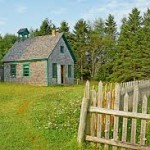 If you are homesteading, chances are you have a garden you regard to in growing crops for your food. There are a lot of considerations in caring for your garden (composting, planting, usually tending, gathering) to secure the plants and produce the greatest yield. There are lots of gardening resources available that focus primarily on the care of dirt and plants, and means to increase yields. Our focus in this post is to go over the fencing around your garden to help protect the location from wind and unwanted animals that are intent on devouring your crops.
If you are homesteading, chances are you have a garden you regard to in growing crops for your food. There are a lot of considerations in caring for your garden (composting, planting, usually tending, gathering) to secure the plants and produce the greatest yield. There are lots of gardening resources available that focus primarily on the care of dirt and plants, and means to increase yields. Our focus in this post is to go over the fencing around your garden to help protect the location from wind and unwanted animals that are intent on devouring your crops.
As a homesteader, you are most likely wanting the most useful lasting option for fencing around your garden and asset. When considering your options for fencing, personal privacy and shelter are 2 crucial areas that will likely come to mind. The latter is frequently a problem in yards which are exposed to cold prevailing winds. Both these points are important not just for the gardener himself, but likewise for the plants in his garden.
Young plant development can be seriously harmed by cold winds and frequent buffeting will cause a large amount of root disturbance. Although personal privacy and shelter can be offered by trees and hedges, fences likewise have an important part to play. Simply as you finish with your garden, you will want to invest time in preparing your fencing task. You will need to think about precisely the things that you are attempting to protect from. A four-foot high fence could shield your crops from bunnies, however will offer little protection in shutting out deer. The bottom line is, thoroughly prepare your garden fencing based on your lasting demands.
The choice of fencing should never ever be undertaken lightly, for major consideration must be given to its look and construction. Homesteading is usually a long-term plan, so you will wish to build a fence that will provide a more-permanent solution for your needs.
Homesteading and Self-Reliance Resources
Strength is very important. A fence is only as strong as its supports. Most fences are supplied with strong posts, generally 4-6in (10-15cm) square. Sometimes concrete posts are provided; these are incredibly strong. Strength of lumber also depends on the avoidance of rot, and unless cedar wood is used (other than for posts), all timber should be treated with an efficient chemical. Creosote can be utilized, although it needs to be allowed to soak into the wood for numerous weeks before plants are trained against it. Unless this is done, there is the hazard of stem and leaf scorch and its use is not typically advised where plants are to be grown against or near a fence. A much safer treatment consists of using copper naphthenate chemicals such as the green, horticultural grades of Cuprinol or Solignum.
Types of fencing
The most popular types are bought as facilities or panels. Normally they are from 5-6ft (1.5-1.8 m) in length with heights varying from about 3-6ft (90cm-1.8 m). A solid or close boarded fence is, as its name indicates, a design which consists of upright or horizontal strips of wood, some 6in (15cm) wide and 1in (2-2.5 cm) thick. The strips are nailed to two or more supporting rails at the rear of the panel. These offer complete personal privacy and wind defense.
Weather board fencing consists of wedge-shaped strips of wood, (1 in 2cm) in thickness at one edge, tapering to 0.5 in (1cm) at the various other. Each strip overlaps the next by about 1 in(2cm). The advantage of this design is that it is practically peep proof.
Trellis fencing is suited as a support for climbing up and tracking plants. It is not a strong design however can be made use of to excellent benefit for covering unpleasant walls or as an added part of a fence design. It usually includes laths of wood 1 by 3/4in (2.5 by 1.5 cm) thick, fastened across each other vertically and horizontally to form 6-8in (15-20cm) squares. The laths are affixeded to a more significant framing of 1 or 1in (2.5 or 3cm) square wood.
Some of the most up to date advances in fence manufacturing is the sale of kits which are so properly machined and total that even an unskilled individual can set up panels without any problem. With these kits have actually come new ideas in design, and many can be made up into contemporary designs. This is particularly beneficial where strong impacts are needed in the building of outdoor patios. Many ultra-modern homes are being developed and this advance in fence appearance will be welcomed by their business owners.
Fencing can likewise be offered in the form of chain link or harmonize netting. The very best quality is heavily galvanized to hold up against the rigors of the weather condition.
An even more current development is the plastic covering of chain link over the galvanized wire. Requirement colors of dark green, black, white, yellow and light eco-friendly can be acquired.


